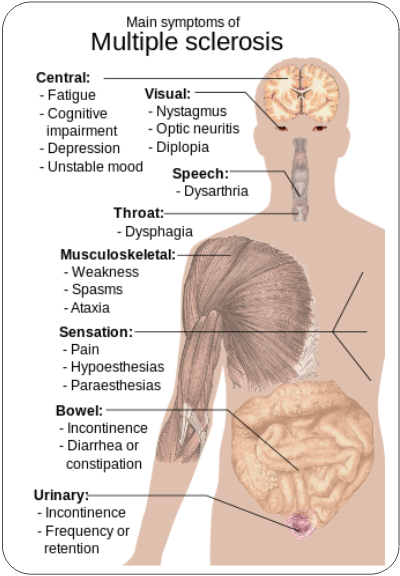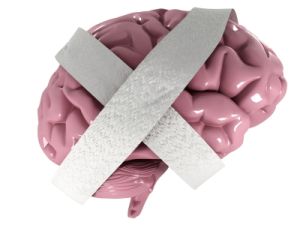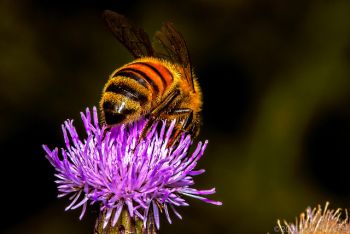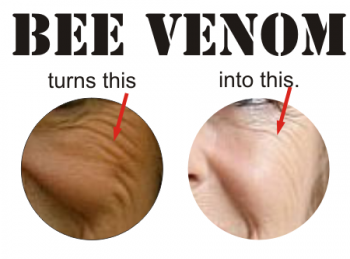Talking about bee venom for therapy, we know that in some countries, bee venom is used to cure diseases such as arthritis, rheumatism, gout, and many other painful joint conditions. Recently, there has been a serious interest in Western countries in researching bee venom effects on neurodegenerative diseases like Alzheimer’s disease, Parkinson’s disease, ALS and multiple sclerosis (MS).
The enzyme ‘Hyaluronidase’ found in bee venom dissolves scar tissue on the myelin sheath, improving synaptic transmission. Other benefits include improved circulation, better bladder control, less fatigue and a feeling of ‘well-being’.
Many other conditions have been successfully treated using bee venom including asthma, PMT, male impotence, psoriasis, epilepsy, ME, depression and some types of cancer.
What is Multiple Sclerosis (MS)?
MS is an inflammatory disease in which the insulating covers of nerve cells in the brain and spinal cord are damaged.
It is a disease of the central nervous system that disrupts the flow of information within the brain, and between the brain and body.
Meaning, that the brain will stop communicating with the body or even parts of the brain will stop communicating among them.
This will result in a wide range of signs and symptoms, including physical, mental, and sometimes psychiatric problems. As a conclusion, it affects the functionality of the entire body.
MS is considered to be an autoimmune disorder that affects the central nervous system.
The cause:
The cause is not clear, the factors involved can be: immunologic, environmental, infectious, and of course, genetic. Which means, we don’t know what causes it.
The cure:
There is no known cure for multiple sclerosis. Allophatic treatments attempt to improve function after an attack and prevent new attacks. The medications used are poorly effective, have adverse effects and are not well tolerated. Many people pursue alternative treatments, despite a lack of evidence.
Treatment options for ms
There are over 50% of people with MS who use alternative medicine. The treatments may consist in:
– dietary supplementation and regimens,
– vitamin D,
– relaxation techniques such as yoga,
– herbal medicine (including medical cannabis),
– hyperbaric oxygen therapy,
– self-infection with hookworms,
– reflexology and acupuncture,
– bee venom therapy.
Most important components of bee venom and their effect:
MELLITIN:
· provides the “ouch” and the itch in bee venom
· has powerful bactericidal and cytotoxic properties
· produces the signs of inflammation via the release of histamine
· stimulates the pituitary to release ACTH, which stimulates the adrenal glands to produce cortisol, part of
your body’s own healing response
· is 100 times more potent as an anti-inflammatory agent than hydrocortisol, when tested in rats with
arthritis (Nature, Nov. 1974)
MAST CELL DEGRANULATING PEPTIDE:
· leads to the release of histamine which creates the signs of inflammation (swelling, itching, redness,
warmth)
· is the most powerful seizure-inducing agent known to man when injected into the brain (not cross blood
brain barrier)
· increases short-term memory in rats (maze test)
APAMIN:
· blocks Ca2+ dependent K + channels
· enhances long-term synaptic transmission
· shortens duration of a nerve’s action potential
HYALURONIDASE:
loosens the glue (a substance called hyaluronic acid) which connects cells thus making the tissue or extracellular
space more permeable. This facilitates the delivery of healing substances to and the elimination of waste or toxic substances from a damaged area.
DOPAMINE (neurotransmitter):
· a neurotransmitter that increases motor activity. It is deficient in Parkinson’s patients and excessive in psychotic patients treated with neuroleptic drugs. Dopamine, along with Serotonin and other catecholamines are implicated as factors in major depression.
ADOLAPIN (neurotransmitter):
· Has an analgesic effect.
How does bee venom work in treating MS?
It is thought that the active compounds in the venom break down the scar tissue that can form on the nerve sheaths as a result of an MS episode. Venom also appears to enhance synaptic transmission, increasing motor activity. All these appear to improve the neuro-functions of the nervous system and reduce the debilitating symptoms of MS.
Bee venom has been used in practice of oriental medicine for a very long time and all specific literature indicates that bee venom plays an anti-inflammatory or anti-nociceptive role against inflammatory reactions associated with arthritis and other inflammatory diseases.
Because many clinical and pathological features of experimental autoimmune encephalomyelitis (EAE) show close similarity to MS, in 2013 a study conducted by LEE, G et al. intended to determine whether bee venom could suppress immune cell differentiation and infiltration into spinal cord on EAE mice, commonly used as a model for MS.
The results showed that “bee venom treatment increased the population of CD4(+)CD25(+)Foxp3(+) T cells and inhibited CD4(+) T-cell proliferation in vitro. In vivo, bee venom treatment increased the population of CD4(+)CD25(+)Foxp3(+) T cells. Furthermore, BV administration reduced the severity of EAE while concurrently decreasing INF-gamma producing CD4(+) T cells, IL-17A producing CD4(+) T cells and inflammatory cytokine production including INF-gamma, IL-17A, TNF and IL-6.
Bee venom treated animals exhibited less infiltration and preserved morphology compared to saline-treated animals.
Interestingly, the therapeutic effects of bee venom on EAE disappeared when CD4(+)CD25(+)Foxp3(+) T cells were depleted by using anti-CD25 antibody. The research suggested that bee venom could be a potential therapeutic agent for anti-inflammatory effects in an animal model of EAE.” ¹
If the MRI brain scan is a reliable way of diagnosing multiple sclerosis, based on the MRIs of patients, venom from both live bees and injections produce the same results. Feedback from clients indicate the minimum benefit to a multiple sclerosis patient is the ability to maintain his or her condition at the onset of treatment. Here are some examples as reported by Mihály Simics in an article published in the Journal of the American Apitherapy Society, Fall 2000, beevenom.com:
• Summary from the MRI of a multiple sclerosis patient after two years using injectable bee venom solution:
Opinion: Stable, if not slightly improved frontal, and temporal lobe areas consistent with demyelinating disease. Slight improvement in posterior fossa white matter changes when compared to 10/14/96. (St. John’s Mercy Hospital, Washington, MO, USA. Dated: 8/23/99, 11:01 AM.)
• Summary from the MRI of the same multiple sclerosis patient in the seventh years of the therapy using the same bee venom solution:
Opinion: Multiple areas of demyelination in the periventricular white matter. These lesions are consistent with the patient’s history of multiple sclerosis. There has been no interval change in the size or number of the plaques. Sinuses are clear. (St. John’s Mercy Hospital, Washington, MO, USA. Dated: Febr. 05, 2003, 12:00)
The advice of experienced apitherapists towards today scientific research is to avoid common mistakes like: use of old venom, venom overdose, and lack of proper protocol and patient support. Of course in these cases, bee venom therapy would fail. Unfortunately those institutes have ignored apitherapists’ advice by now. Hopefully things will change in the future. But until then, we should keep our faith in the decades of experience with good results of apitherapy and not be discouraged by official clinical studies, yet found in an early stage.
Conclusion:
Bee venom therapy in the treatment of multiple sclerosis can be an effective alternative to control the condition. The therapy can be carried out with venom from live bees or with an injectable solution, but must be accompanied with proper nutritional protocol and must follow therapeutic guidelines.
Bee venom should always be administered ONLY by a licensed health practitioner.
More on http://www.beevenom.com/.
Related articles:
• Bee venom
• Bee venom for therapy: General Information
• Bee venom for therapy: Arthritis. What is apipuncture?
• Bee venom for therapy: Alzheimer’s disease
• Bee venom for therapy: Homeopathic Remedies
• Bee venom a possible natural treatment for Parkinson’s disease
• Honey and Alzheimer’s natural treatment
• What is the best cream for wrinkles?
• How to treat bee sting
• Venom Immunotherapy or HOW TO TREAT BEE STING ALLERGY FOR GOOD!
References and picture credits:
– http://en.wikipedia.org/wiki/Multiple_sclerosis
– ¹ LEE, G; LEE, H; PARK, S; JANG, H; BAE, H (2013) Bee Venom Attenuates Experimental Autoimmune
Encephalomyelitis Through Direct Effets on Cd4(+)Cd25(+)Foxp3(+) T Cells. European Journal of
Inflammation 11 (1): 111-121.
– Bee Product Science, bee-hexagon.net, February 2014
– “fight MS” featured picture credit MTSOfan under CC via flickr.com
– “Symptoms of multiple sclerosis” picture by Mikael Häggström, licensed under Public Domain via Wikimedia Commons




Good Afternoon,
In 2014 I did bee sting therapy for my MS. It worked great. I am now looking to start again and I cannot recall the company I ordered my bees from. I am having great difficulty trying to find a company I can buy the bees for my therapy. Do you have any companies, and can you give me their contact information?
Thank you
Sandy Liccardi
Hi Sandy,
Unfortunately I cannot help you with this info. But if it worked so well in 2014, please don’t stop searching for a supplier. Somehow you have to find it.
All the best!
Laura
I have arthritis, a rather rare and nasty type called ankylosing spondylitis, which means my vertebrae and discs are fusing together, and at some point in the not too distant future I will not be able to bend over and touch my knees let alone my toes it causes a lot of inflammation which causes nearly constant pain so I have done a lot of research into these things a well, at some point in chronic pain your body loses the ability to”call off” the dogs and end the inflammation response, so I’m wondering if there might be something in this that might help me, too. and I’m a little confused you sais dopamine and serotonin were factors in MDD, I assumed you meant the lack of sufficient amounts of, but wanted to be sure
Some symptoms of depression, such as low motivation, feeling helpless, loss of interest in, once, interesting things to you, are linked to diisfunction in the dopamine system. And like in a vicious circle, this dysfunction is also triggered by trauma, stress, pain… As for serotonine, yes it was thought that low levels trigger depression, but today it is not considered to be the major cause. However, a treatment which includes increased levels of serotonin has a 40-60% chances to improve the condition. (It is done through the use of selective serotonin reuptake inhibitors for 6-8 weeks)
Depression is related to inflammation, so be careful. These inhibitors also treat inflammation.
Anyway, for arthritis, one effective treatment is honey and cinnamon. Read Cinnamon Honey Benefits. It is useful even for dogs: How to treat a dog’s arthritis naturally!
All the best!
Laura